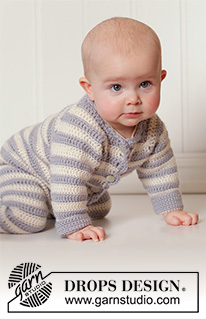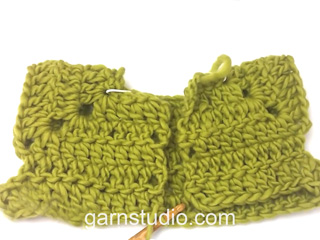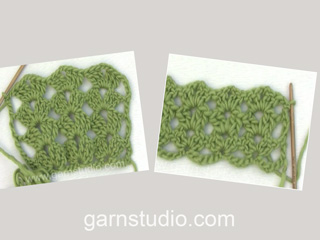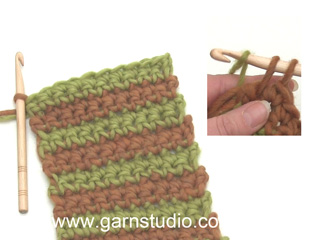Baby Blues |
|
 |
 |
Crochet baby overall with raglan and stripes in DROPS Karisma. Size 0 - 4 years.
DROPS Baby 25-34 |
|
|
CROCHET INFO: Replace first dc at beg of every dc row with 1 ch, finish row with 1 dc in 3rd ch from beg of previous row. Replace first tr at beg of every tr row with 3 ch, finish row with 1 tr in ch from beg of previous row. TEXTURE ROWS: * 1 row dc (worked from WS), 1 row tr (worked from RS) *, repeat from *-* (1 row dc + 1 row tr = 1 texture row). STRIPES: Work entire suit in stripes as follows: * 1 row dc from WS with off white and then 1 row tr from RS with off white, 1 row dc from WS with light blue grey and then 1 row tr from RS with light blue grey *, repeat from *-*. INCREASE TIP: Inc 1 dc/tr by working 2 dc/tr in same st. DECREASE TIP: Work 1 dc/tr but wait with last pull through (= 2 sts on hook), then work next dc/tr but on last pull through, pull yarn through all sts on hook = 1 dc/tr dec. ---------------------------------------------------------- SUIT: The piece is worked top down. Worked back and forth from mid front. YOKE: Work 37-41-45-45 (49-49) LOOSE ch on hook size 4.5 mm with light blue grey. Work 1 dc in 2nd ch from hook, then work 1 dc in every ch the entire row = 36-40-44-44 (48-48) dc. Turn piece and work 1 row with dc back from WS while AT THE SAME TIME inc 8 dc evenly – READ INCREASE TIP = 44-48-52-52 (56-56) dc on row. Now insert 4 markers in piece for raglan as follows (beg mid front – NOTE: Do NOT work while inserting markers): Skip 6-7-8-8 (9-9) dc (= left front piece), insert 1 marker in next dc, skip 8 dc (= sleeve), insert 1 marker in next dc, skip 12-14-16-16 (18-18) dc (= back piece), insert 1 marker in next dc, skip 8 dc (= sleeve) and insert last marker in next dc (there are now 6-7-8-8 (9-9) dc on right front piece after last marker). READ ALL OF THE FOLLOWING SECTION BEFORE CONTINUING: Work next row as follows from RS: Work 1 tr in every dc but in every dc with marker work 2 tr + 2 ch + 2 tr = 56-60-64-64 (68-68) tr on row. Then work TEXTURE ROWS and STRIPES – see explanation above (work back and forth with 1 dc/tr in every st from previous row but on every row with dc from WS work 2 ch over the 2 ch from previous row in raglan lines). AT THE SAME TIME on 1st row from RS (i.e. row with tr) inc for raglan as follows: Work 2 tr + 2 ch + 2 tr in every ch-space in every raglan line (= 16 tr inc on row - NOTE: Work in both ch-spaces). Repeat inc on every row from RS 3-4-4-5 (5-6) more times (= 4-5-5-6 (6-7) times in total) = 120-140-144-160 (164-180) sts. REMEMBER THE CROCHET TENSION! After last inc for raglan work 1 row with dc from WS as before. Work next row as follows from RS: Work 1 tr in each of the first 16-19-20-22 (23-25) dc (= left front piece), skip the next 28-32-32-36 (36-40) dc (= sleeve), work 4-4-4-6 (6-8) ch, work 1 tr in each of the next 32-38-40-44 (46-50) dc (= back piece), skip the next 28-32-32-36 (36-40) dc (= sleeve), work 4-4-4-6 (6-8) ch and work 1 tr in each of the last 16-19-20-22 (23-25) dc (= right front piece). Then finish body and sleeves separately. BODY: NOW MEASURE PIECE FROM HERE! Work 1st row from WS – work 1 dc in every tr from previous row and 1 dc in each of the 4-4-4-6 (6-8) ch under each armhole = 72-84-88-100 (104-116) dc on row. Continue back and forth with texture rows and stripes as before – remember CROCHET INFO! AT THE SAME TIME on 1st row (= tr from RS), inc 4-0-2-2 (4-6) tr evenly = 76-84-90-102 (108-122) tr. When piece measures approx. 24-29-34-39 (44-48) cm from neck (i.e. approx. 27-32-37-42 (47-51) cm from shoulder) – adjust so that last row is 1 row with off white and tr from RS, finish opening for band mid front. Insert a marker in each side. Continue back and forth as before. When piece measures 27-32-38-43 (49-53) cm from neck (and 30-35-41-46 (52-56) cm from shoulder), divide for legs and finish each leg separately. LEG: Insert 1 marker – NOW MEASURE PIECE FROM HERE. Continue with texture rows and stripes back and forth over the first 38-42-45-51 (54-61) sts on row (i.e. over half of sts). When leg measures 2 cm from marker, dec 1 dc/tr in each side - READ DECREASE TIP. Repeat dec every 2-2-3-3½ (3½-3½) cm 4-4-4-4 (5-7) more times (= 5-5-5-5 (6-8) times in total) = 28-32-35-41 (42-45) sts. When leg measures 11-14-17-20 (25-30) cm from marker, switch to light blue grey and work dc back and forth for 4 cm. Fasten off. Leg measures approx. 15-18-21-24 (29-34) cm and entire suit measures approx. 45-53-62-70 (81-90) cm from shoulder. Work the other leg the same way. SLEEVE: = 28-32-32-36 (36-40) sts. Insert 1 marker here – NOW MEASURE PIECE FROM HERE. Work first row as follows from RS (continue stripes as before): Work 2-2-2-3 (3-4) ch, work 1 tr in every st and work 2-2-2-3 (3-4) ch. Turn piece, work 1 dc in 2nd ch from hook, work 1 dc in each of the next 0-0-0-1 (1-2) ch, 1 dc in every tr from previous row and 1 dc in each of the 2-2-2-3 (3-4) ch from beg of previous row = 32-36-36-42 (42-48) sts on row. Continue the texture rows and stripes back and forth as before. AT THE SAME TIME when sleeve measures 2 cm from marker, dec 1 st in each side - READ DECREASE TIP. Repeat dec every 2-2-2½-2 (2-2) cm 3-4-4-7 (7-9) more times (= 4-5-5-8 (8-10) times in total) = 24-26-26-26 (26-28) sts. When sleeve measures 9-11-13-15 (19-24) cm from marker, switch to light blue grey. Work dc back and forth for 4 cm, fasten off. Sleeve measures 13-15-17-19 (23-28) cm from marker. Work the other sleeve the same way. ASSEMBLY: Sew sleeve seams tog edge to edge in front loop of outermost sts. Sew the openings under the sleeves. Fold if desired the edge at the bottom of sleeves. Sew the opening mid front from markers where band ends and down to dividing for legs - sew in front loop of outermost st. LEFT BAND: Beg from WS at the bottom on left front piece with light blue grey and work 1 dc in tr at the edge on the off white stripe, * work 2 tr + 2 ch + 2 tr in next tr (i.e. in tr at the edge on light blue grey stripe), 1 dc in next tr (i.e. in tr at the edge on off white stripe) *, repeat from *-* up along left front piece to neck and finish with 1 sl st at the edge on corner by neck. Turn piece and work as follows back from RS: 3 ch (= 1 tr), then work 1 tr between every st and 1 tr in ch-space in every tr-group. Fasten off. Fasten band at the bottom by dividing for legs. RIGHT BAND AND NECK EDGE: Work as left band but beg from RS at the bottom on right front piece, work as left band up to neck but instead of finishing with 1 sl st in the corner by neck, continue edge around the neck as follows: Work 1 dc in every st along the neck until 3 sts remain before raglan line, skip these 3 sts and work 4 tr in st in raglan line, skip the next 3 sts and continue with 1 dc in every st until 3 sts remain before next raglan line, skip these 3 sts and work 4 tr in st in next raglan line. Continue like this around the neck and finish with 1 sl st at the edge on row. Turn piece and work 2nd row as on left band. Fasten off. MORE ASSEMBLY: Sew the buttons on to the left band. Beg with 1 button in the upper light blue grey stripe, then place 1 button in every other light blue grey stripe. Button through hole on the inside of "fan" on band. |
|

|
|
|
Have you made this or any other of our designs? Tag your pictures in social media with #dropsdesign so we can see them! Do you need help with this pattern?You'll find tutorial videos, a Comments/Questions area and more by visiting the pattern on garnstudio.com. © 1982-2024 DROPS Design A/S. We reserve all rights. This document, including all its sub-sections, has copyrights. Read more about what you can do with our patterns at the bottom of each pattern on our site. |
|







































Comments / Questions (60)
Sicuramente potevo anche arrivarci....sono entrata in confusione e ho disturbato inutilmente...... grazie x la pazienza Paola
21.08.2017 - 14:59Buongiorno non capisco questo "Lavorare 2 m.a + 2 cat + 2 m.a in ogni arco di cat in ogni raglan (= 16 m.a aumentate - ATTENZIONE: Lavorare nei 2 archi)" quali sono i due archi! Ne ritrovo solo uno... Grazie
20.08.2017 - 14:22DROPS Design answered:
Buongiorno Paola. Deve lavorare nei due archi di catenelle dei due giri sotto. Buon lavoro!
20.08.2017 - 17:58Grazie!!!!
28.07.2017 - 22:42Salve, mi serve consiglio x fare taglia 3/6 mesi. Vedo che non viene indicata, anche in altri modelli. C'è qualche trucco x fare questa taglia di mezzo.? Nelle misure indicate ad es. X lunghezza si passa da 53 cm (taglia 1/3) a 62 cm (taglia 6/9) Grazie mille!
28.07.2017 - 18:21DROPS Design answered:
Buongiorno Paola. Potrebbe per esempio lavorare una lunghezza di 57 cm o misurare un capo analogo . Generalmente si consiglia di lavorare i vestiti per bimbi piccoli in una taglia più grande per poter essere indossati un po' di più. Buon lavoro.
28.07.2017 - 19:07Jag förstår inte hur jag ska göra armarna. I armhålan är det fm och resten är också fm senaste varvet. Det är alltså meningen att jag ska börja i armhålan? Och virka fram och tillbaka för att sedan sy ihop när klart.. Men hur börjar jag? Om jag gör massa luftmaskor som de står i beskrivningen så blir det ju stora hål... Tacksam för snabbt svar
12.05.2017 - 11:55DROPS Design answered:
Hej Sanne, jo men du skall börja som det står i mönstret med 2 lm(se din str), sedan 1 fm i varje m och 4 lm (se din str). Det blir ett mindre hål under ärmen, men det syr du när du kommer till monteringen. Lycka till!
12.05.2017 - 12:27Hej! När jag gjort oket går jag över till att virka fram- och bakstycke. Då står det "Härifrån mäts nu arb!" Men när jag kommer längre ner i beskrivningen så står det "När arb mäter ca nn cm från halsen (dvs ca nn cm från axeln......) Varifrån ska jag mäta? Från markören eller från hals/axel? M v h Anette
21.12.2016 - 12:53DROPS Design answered:
Hej Anette. Jeg ville maale som der staar i opskriften: Når arb måler ca 24-29-34-39 (44-48) cm fra halsen (dvs ca 27-32-37-42 (47-51) cm fra skulderen) og saa ignorere den "HERFRA MÅLES ARB VIDERE!" som staar i starten.
21.12.2016 - 14:28Jessica wrote:
Hejsa! Jeg forstår ikke helt hvad der menes i dette skridt "Repeat dec every 2-2-3-3½ (3½-3½) cm / 3/4”-3/4”-1 1/8”-1¼” (1¼”-1¼”) 4-4-4-4 (5-7) more times (= 5-5-5-5 (6-8) times in total) = 28-32-35-41 (42-45) sts." – Kan nogen forklare det for mig?
11.11.2016 - 19:26DROPS Design answered:
Hej Jessica. Du skal gentage indtagningen 4-5 eller 7 gange mere paa hver x antal cm (afhaengigt af hvilken str du laver) saa du har 28-32-35-41 (42-45) m naar du er faerdig.
14.11.2016 - 15:14Ist mein erstes Kleidungsstück dass ich häkle habe also noch keine große Erfahrungen darin. Ich bin jetzt bei den Strukturmusterreihen und streifen angekommen. Meine Frage dazu lautet mache ich jetzt eine Strukturmusterreihe mit grau und fange dann mit den Streifen an in Natur? Kommt dann irgendwann nochmal eine Strukturmusterreihe?
10.11.2016 - 21:25DROPS Design answered:
Liebe Meike, siehe Antwort unten.
11.11.2016 - 09:54Ist mein erstes Kleidungsstück dass ich häkle habe also noch keine große Erfahrungen darin. Ich bin jetzt bei den Strukturmusterreihen und streifen angekommen. Meine Frage dazu lautet mache ich jetzt eine Strukturmusterreihe mit grau und fange dann mit den Streifen an in Natur? Kommt dann irgendwann nochmal eine Strukturmusterreihe?
04.11.2016 - 19:24DROPS Design answered:
Liebe Meike, Sie haben jetzt eine R. fM + 1 R Stb mit Hellgraublau gehäkelt, jetzt fangen Sie die Streifen an: *mit Natur (1 R fM, 1 R Stb), mit Hellgraublau (1 R fM, 1 R Stb)* von *-* wiederholen.
07.11.2016 - 08:47Som flere efterspørger er der også her vrøvl med at komme i gang med ærmerne - hvor skal jeg starte på ærmet? I teksten står der bare: ÆRME: = 28-32-32-36 (36-40) m. Sæt 1 mærke – HERFRA MÅLES ARB VIDERE. Første række hækles således fra vrangen (striberne fortsættes som før): Hækl 2-2-2-3 (3-4) lm, hækl 1 fm i hver m og hækl 4-4-4-5 (5-6) lm. Hvor skal jeg tælle 40 m fra og sætte mærket? og hvor skal jeg starte med lm fra? Håber i kan hjælpe mig videre, for glæder mig til det færdige arbejde.
05.10.2016 - 11:54DROPS Design answered:
Hej Charlotte. Du har jo lukket af til ermer tidligere paa baerestykket (spring over de næste 28-32-32-36 (36-40) fm (= ærme)). Du har altsaa to aabninger överst med 40 fm i hver. Du saetter 1 maerke her hvor du starter (det er for du kan maale laengden paa aermet). Og jeg ville starte midt under aermet, saa har du overgangen paa hver omg paa underkanten af aermet.
27.10.2016 - 16:18